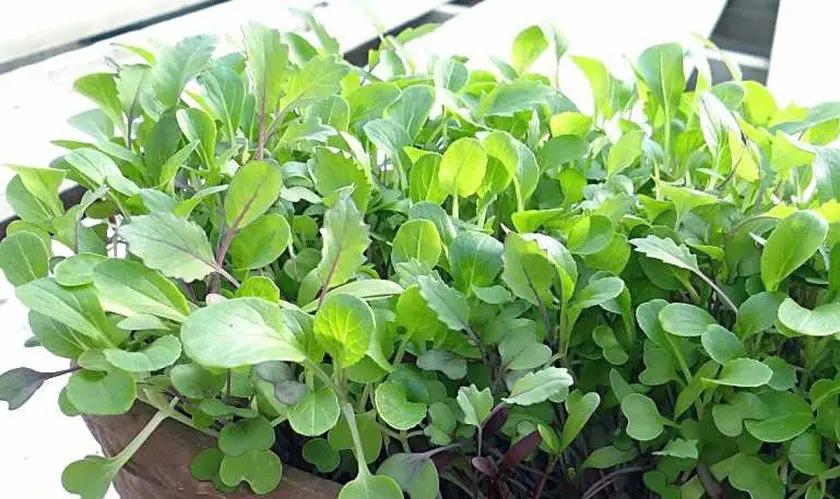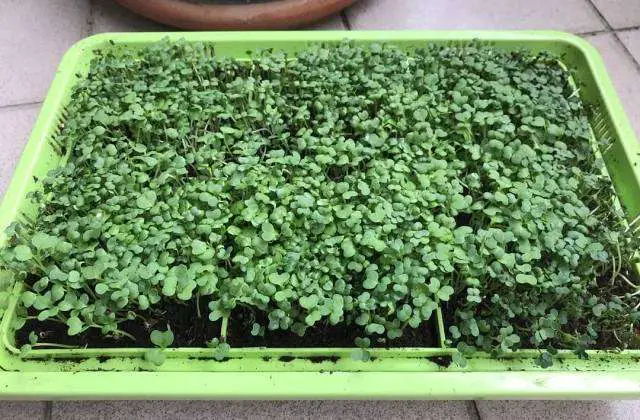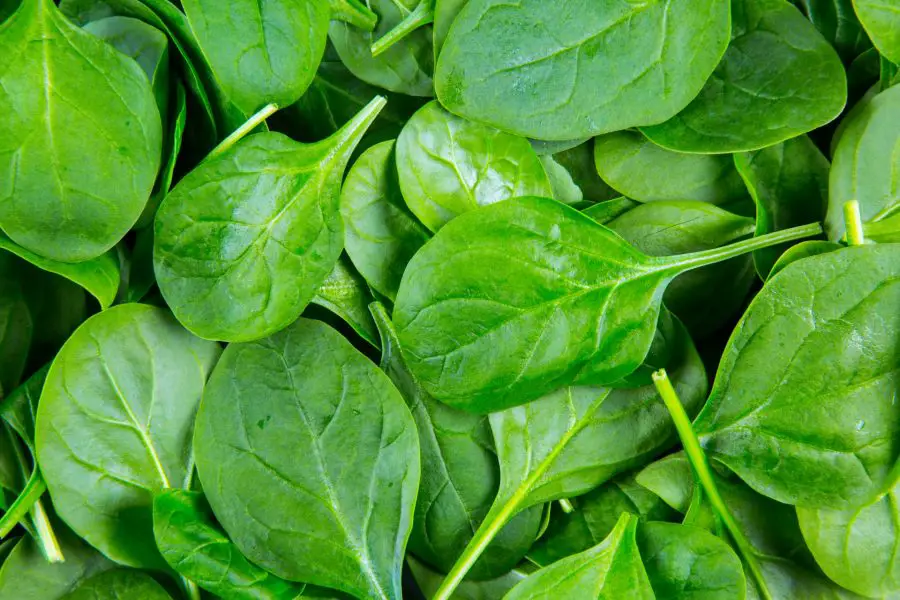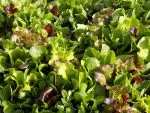This post contains affiliate links. If you buy something from one of our links we may earn a commission. Thanks

Do you want to learn how to grow spinach microgreens in 7 easy steps? We will discuss how to get started with growing your own microgreens.
Growing Spinach Microgreens In A Nutshell
To grow spinach microgreens, you’ll need to follow a few steps to ensure a healthy, vibrant yield.
The process is easy and can be highly rewarding. Microgreens are essentially young vegetable greens that are harvested just after the cotyledon leaves have developed.
They are known for their nutritional potency and are used in salads, sandwiches, and a variety of dishes.
Here’s a straightforward guide on how to grow spinach microgreens indoors:
Get Your Supplies:
Seeds: Purchase high-quality spinach seeds from a reputable supplier.
Growing Tray: Acquire a shallow growing tray with drainage holes.
Soil: Use organic, well-draining soil or a soilless medium like coconut coir.
Light Source: Natural sunlight or a full-spectrum grow light will do.
Water: Have a spray bottle for watering.
Prepare the Growing Medium:
Fill your tray with the growing medium, leveling it out without pressing it down.
Sow the Seeds:
Sprinkle the spinach seeds evenly across the surface of the soil.
Press them gently into the soil using a flat board or your hand but do not cover them as spinach seeds need light to germinate.
Water and Cover:
Mist the seeds gently with water using a spray bottle.
Cover the tray with a humidity dome or another tray to retain moisture.
Germination:
Place the tray in a warm, well-lit area.
Keep the soil moist by misting it lightly as needed, usually once or twice a day.
Remove the cover once the seeds have sprouted, which should occur within a week.
Lighting:
Ensure your microgreens receive about 12-16 hours of light per day, whether from a sunny windowsill or under a grow light.
Watering:
Keep the soil moist but not waterlogged. It’s often best to water from below to prevent mold and diseases.
Harvesting:
Your spinach microgreens should be ready to harvest in about 2-3 weeks, once they’ve reached a height of about 2-3 inches.
Use a sharp pair of scissors to cut the microgreens just above the soil line.
Enjoy:
Rinse your microgreens well, and they are ready to be enjoyed in a variety of dishes!
With these steps, you can enjoy fresh, nutritious spinach microgreens grown right in your home.
Remember, consistency in monitoring and caring for your microgreens is key to a healthy, bountiful yield. Happy growing!
We will also provide a step-by-step guide on how to grow your own spinach microgreens.
They are one of the easiest microgreens to grow and no green thumb is needed. You only need a little space to do it so why not grow your own food and skip the grocery store?
You can also grow them a bit longer to harvest baby greens which is another great way to grow them. So, whether you are a beginner or an experienced gardener read on for more.
How To Grow Spinach Microgreens In 7 Easy Steps
You can grow spinach microgreens in as little as 2 weeks but I think the best way is to wait a few weeks more for baby spinach microgreens.
Not sure if growing microgreens is for you. Here’s 5 reasons to grow microgreens at home.
1. Get the right materials:
You’ll need a seed tray, soil mix, and some spinach microgreens seeds to get started. Here’s a link to some organic, non-GMO Bloomsdale Spinach Seeds.
Make sure your vegetable seeds are organic seeds and non-GMO too. Make sure you have a space in your garden or on your balcony for your microgreens.
Use shallow trays. 1020 microgreen trays will give you the best results. Use a tray with holes and place it in a tray of water to bottom water your growing medium.
That way seeds won’t get uncovered or moved around by top watering.
2. Prepare the soil:
You can mix your soil with compost or other organic matter until it has an ideal texture for growing microgreens. It should be light.
Potting mix works fine but if it is heavy mix some perlite in to lighten it up. Use coco coir instead for a better germination rate.
Then spread your growing medium out evenly over the seed tray about a half inch from the top.
Moisten your soil before planting your seeds. Bottom watering is a great way to do this but misting can also work.
3. Plant the seeds:
Don’t soak your seed. It may speed up germination a bit but it makes sowing seeds evenly much harder.
Spread out the microgreen spinach seeds on top of the soil in your tray, making sure they are evenly distributed throughout it and not clumped together too much.
If you are growing microgreens the seeds should almost be touching. But if you are going to grow baby spinach greens you can plant a bit thinner.
Then lightly press them into the surface of the soil using your fingers and cover them with a thin layer of soil. Your microgreen seeds will germinate in 5-10 days.
Place an empty growing tray on top of the seeds after planting to conserve moisture but remove it when the seeds start to sprout.
4. Water your tray:
Water the seed tray until it is moist, but not soggy. Use a spray bottle to mist your plants.
If you bottom watered your tray it shouldn’t take too much to water it. Be careful not to overwater.
5. Place in sunlight:
Place the seed tray in an area that receives at least 6-8 hours of direct sunlight each day.
Make sure your spinach seeds have enough light because good light is important for fast growth.
If you don’t have access to a sunny outdoor space or south-facing window for growing your microgreens, consider investing in some grow lights.
You will want to use an LED grow light during the winter months when light levels are naturally lower.
6. Harvesting and storage:
Once your spinach microgreens have grown to about 2 inches tall, with the first set of true leaves starting to show you are ready to harvest them.
Use scissors to cut just above the soil surface and store your freshly harvested microgreens in the refrigerator for up to 7 days.
You can harvest more mature plants as baby spinach greens if you give them more time to grow.
If you want an extended harvest don’t cut your plants down. Instead, you can harvest individual leaves and as long as you leave some on the plant it will grow more leaves.
Don’t use an airtight container or plastic bag. You want ventilation holes in them.
7. Enjoy your fresh spinach microgreens:
And there you have it. Now you know how to grow microgreens. You’ve successfully grown some delicious and nutritious spinach microgreens in just 7 easy steps. Now, all that is left to do is enjoy them in salads, smoothies, or as a side dish with any meal of the day.
Follow these simple steps and you should have no trouble growing your own spinach microgreens o in no time. Have fun experimenting with different types of soil, seeds, and containers until you find what works best for you.
With a little bit of patience and practice, you’ll soon be harvesting flavorful microgreens right from your own home garden. Happy planting.
What’s The Difference Between Spinach Microgreens And Baby Spinach?

Spinach microgreens and baby spinach are two different stages of the spinach plant. Spinach microgreens are the very first stage of growth after the seeds have germinated and sprouted, while baby spinach is the next stage of growth after the microgreens stage.
Spinach microgreens are the very first stage of growth for the spinach plant and are harvested when the plant is just a few inches tall and just before they show their first true leaves.
They are often used as a garnish or added to salads for a burst of flavor. Because they are so young, they are packed with nutrients and have a mild, delicate flavor.

Baby spinach, on the other hand, is the next stage of growth after the microgreens stage. It is typically harvested when the leaves are larger and the plant is more established.
Baby spinach leaves are generally more mature than microgreens, and have a slightly stronger flavor. They are often used in salads and as a cooking green.
Overall, the main difference between spinach microgreens and baby spinach is the stage of growth at which they are harvested.
Microgreens are harvested at a very young stage, while baby spinach is harvested when the plant is more established. This can affect the flavor and nutrient content of the two types of spinach.
Spinach Growing Conditions
Spinach plants grow best in cool temperatures and prefer a soil that is rich in organic matter and well-draining. It also prefers slightly acidic soil with a pH of 6.0-6.8.
In terms of light, spinach grows best in full sun. It is important to make sure the soil stays moist, but not waterlogged, and to water the plants at the base to avoid wetting the leaves. It is also a good idea to mulch the soil around the plants to help retain moisture and control weeds.
Soil And Air Temperatures
The ideal soil temperature for growing spinach is between 60-65°F. When the soil temperature is too hot, the spinach will bolt, or go to seed, and the leaves will become bitter.
In terms of air temperature, spinach grows best in cool weather and can tolerate light frosts.
In fact, some varieties of spinach are actually sweeter after a frost. It is important to protect the plants from extreme temperatures, either very hot or very cold, to ensure they grow properly.
Spinach Microgreens Benefits
Disclaimer: I am not a physician and don’t play one on TV either. The material on this site is not a substitute for professional medical advice, diagnosis, or treatment. Always seek a physician’s advice before using any information you find on this website to treat or prevent any condition.
Microgreens have been shown to be 4-20 times more nutritious than their full-grown counterparts.
Spinach is an extremely nutrient-rich vegetable. It packs high amounts of carotenoids, vitamin C, vitamin K, folic acid, iron, and calcium. https://www.healthline.com/nutrition/foods/spinach
Not only are spinach microgreens extremely easy to grow, but they also offer a variety of health benefits. They are rich in vitamin A, vitamin C, vitamin e, and vitamin K, as well as iron and calcium.
Additionally, they contain many powerful antioxidants that can help protect your cells from damage caused by free radicals.
Spinach microgreens have been linked to lower cholesterol levels and improved digestion, while also providing anti-inflammatory properties that can reduce inflammation throughout the body.
All in all, adding spinach microgreens to your diet is an excellent way to ensure you’re getting enough essential nutrients.
Spinach microgreens are a unique type of vegetable grown from an early stage of germination. With a slightly sweeter taste than regular spinach, these delicate greens offer much more than flavor.
Not only are spinach microgreens filled with essential dietary fiber, iron, and magnesium, but they also contain high levels of antioxidants which help your body fight off harmful free radicals that can damage cells and cause disease.
Additionally, the vitamins contained within spinach microgreens have been shown to benefit cognitive function and further improve overall well-being. This super-packed veggie is the perfect addition to any meal or snack.
Spinach Microgreens Nutrition
Spinach microgreens are an amazing little powerhouse of nutrition. These healthy microgreens have a high nutritional value and are a popular variety of sprouted microgreens, and they contain essential vitamins and minerals that can benefit your health in many ways.
Spinach microgreens offer huge amounts of antioxidants, which help to reduce inflammation and protect against free radical damage.
They are also rich in Vitamin C and Vitamin A, both of which play an important role in maintaining vision, heart health, and healthy skin.
So try adding some to your morning smoothie or midday salad for a burst of flavor and nutrition.
Spinach Microgreens Vs Baby Spinach
When deciding between spinach microgreens and baby spinach, it’s important to consider how you plan on using them.
Microgreens offer a bolder, more intense flavor than baby spinach and are often used as garnishes or for salads that need a flavorful kick.
On the other hand, baby spinach is slightly milder in flavor and is ideal for dishes that require delicate seasonings such as soups and dips.
Both types of spinach are excellent sources of essential vitamins and minerals, so no matter what your culinary needs may be, either type could be a great choice.
How To Use Spinach
There are many ways to use spinach in your cooking. Here are a few ideas:
• Add fresh spinach leaves to salads for a nutrient-rich and colorful addition.
• Sauté spinach with garlic and olive oil for a quick and easy side dish.
• Use spinach in soups, stews, and pasta dishes for added flavor and nutrition.
• Mix fresh or frozen spinach into smoothies for a healthy and tasty breakfast or snack.
• Use cooked, drained spinach as a filling for omelets, quiches, or savory pastries.
Remember to wash spinach thoroughly before using it, and to remove any tough stems or damaged leaves. You can also use baby spinach leaves, which are smaller and more tender than mature spinach leaves.
How To Store Spinach
Here are a few tips for storing spinach:
• Fresh spinach should be stored in the refrigerator, ideally in a plastic bag with holes and damp paper towels to keep it from drying out.
• Spinach can be stored in the refrigerator for up to a week, although it will start to lose its quality after a few days.
• If you have more spinach than you can use within a week, you can freeze it for longer storage. To freeze spinach, wash and dry it thoroughly, then blanch it in boiling water for a minute or two.
You can skip blanching particularly if you are not going to keep it for a long time but blanching slows down the enzymes in vegetables that can cause a loss of flavor, texture, or color.
• Drain the spinach and let it cool, then squeeze out any excess water and pack it into freezer-safe bags or containers. Frozen spinach will keep for up to a year.
• When using frozen spinach, thaw it in the refrigerator overnight or in cold water, then squeeze out any excess water before using it in your recipe. Frozen spinach will be more watery than fresh spinach, so it is best used in cooked dishes where the excess moisture can be cooked off.
Here is my article about how to store microgreens.
FAQs
How long does it take to grow spinach microgreens?
It typically takes about 7-14 days for spinach microgreens to grow. The exact time will depend on the specific variety of spinach, as well as the growing conditions, such as the temperature, moisture, and lighting.
Spinach will grow well at room temperature in fact warm temperatures can make spinach bolt and go to seed.
Most spinach microgreens are ready to harvest when the first true leaves have developed, which is usually around 7-14 days after planting.
How long does it take to grow baby spinach?
It typically takes about 30-40 days for baby spinach to grow. The exact time will vary depending on the growing conditions, temperature, moisture, and lighting.
Most baby spinach is ready to harvest when the leaves are young and tender, which is usually around 30-40 days after planting. To check if your baby spinach is ready to harvest, inspect its leaves. If the leaves are bright green and tender, they are ready to be harvested and enjoyed.
Do spinach microgreens regrow after cutting?
Yes, spinach microgreens can regrow after being cut. However, they will not regrow to their full size, and the regrowth may not be as nutritious as the original microgreens.
To encourage regrowth, don’t cut the microgreens above the soil line. Instead remove individual leaves from your plants.
Then, keep the soil moist and provide the plants with adequate light, light fertilization and they should begin to regrow.
The regrowth may take a few days to a week to appear, and it may be smaller and less flavorful than the original microgreens.
It is generally best to harvest all of the microgreens at once, rather than trying to regrow them.
Can microgreens be grown without soil?
Yes, you can grow spinach microgreens and many others without soil. You can use a moistened coco grow mat and sow your seeds on top of it. Cover seeds until they germinate and then move to the light.
Here is an article on growing microgreens without soil using coco grow mats.







